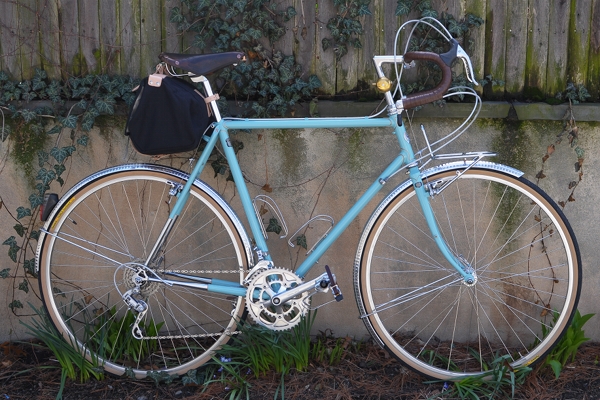It has been so nice to see more and more people revamping vintage bicycles over the past several years, riding them, and sharing pictures with others. Seeing vintage bikes actively ridden and lovingly cared for feels as if history is "interacting" with our contemporary lives - reestablishing a sense of continuity that has been ruptured in many ways over the past several decades. But as the use of vintage bicycles grows more popular, it is worth noting that not everybody holds the same views on refurbishing them. For me, discovering these differences has been educational, and I will try to describe some of the approaches I have come across:
The Full Restoration Approach
To "restore" a bicycle typically implies bringing it back to its former glory inasmuch as possible. If the bicycle is not in great cosmetic shape, then this may include re-painting the frame in a colour painstakingly matched to the original, finding new-old-stock original decals or replicas, and taking the trouble to locate well-preserved versions of the components and accessories, if the original ones cannot be cleaned up sufficiently well. The end goal is for the bicycle to resemble as closely as possible what it looked like when it was sold as new - be it the 1970s or the 1910s.
The All-Original Approach
In direct opposition to those who restore bicycles, are those who prefer to keep them all-original - meaning in whatever condition the bicycle was found. The reasoning behind this approach, is that a vintage bicycle is a piece of history and should be preserved in its found state. Some who adhere to this method will clean up the components and frame as much as possible - as long as it does not involve repainting or replacing anything on the bike. Others will take things to the extreme and literally leave the bicycle as is - including any dirt or rust that has accumulated on it. Some will perform repairs, as long as the components remain original; while others believe that if the bicycle is not ridable without repairs, then that is how it should stay.
The Period-Appropriate Approach
This approach is somewhat similar to restoration, but is considerably more relaxed and is done with the intent for the bicycle to be ridden, not collected or exhibited. Those who prefer this method, typically clean up and refurbish the bicycle in a way that keeps its appearance period-appropriate without going so far as to replicate the original components, accessories and colour scheme. For example, the bicycle above has been repainted a soft blue - a traditional colour choice for vintage touring bikes, but not the original frame colour. The components selected are also traditional for the time period the owner wanted to evoke, but they are not the components that originally came with this bike. The period-appropriate approach is popular among those who want the bicycle to suit their tastes and riding style, while still paying homage to the era from which it came.
The Updated Remix Approach
Some cyclists prefer to fit vintage frames with modern components - either in part or entirely. The reasoning behind this, is that while they may prefer the looks, ride quality, craftsmanship and other aspects of the older frames, newer components tend to be more comfortable and more convenient. This can include anything from using a modern style of handlebars, brake levers and cranks, to fitting the bicycle with clipless pedals and new high-tech lights. While the newer components are not even remotely original or period-correct, some owners will attempt to make the overall look of the bicycle harmonious. To others this does not matter so much, and they regard the vintage and modern mix as purely utilitarian. If I had to classify the current fixed gear modification trend (whereby parts of the frame are filed off and the bike is fitted with super-modern wheels and colourful components), it would go in this category as well. The degree of consideration that is given to the original frame is up to the owner.
[Jeunet porteur, image via somervillain]
Over the past two years, I have spoken with vintage bicycle owners whose approaches run the full spectrum of these categories, and have at times been amazed by how strong views on this topic can be. Restorers are criticised for recklessly altering pieces of history. Those who keep vintage bikes original are criticised for not giving the bicycle a chance to "live again". Those who take the trouble to set up their bicycle in a period-appropriate manner are perceived as obsessive "retrogrouches." And those who put modern components on vintage frames are accused of butchering or "not caring enough" about vintage bikes. Personally, I can see the benefit in all methods, and I think that quite a lot depends on the bicycle itself - how rare and historically significant it is. The Co-Habitant and I have used the "updated remix" approach at least to some extent on most of our vintage bikes - but none so far have been historically valuable. What is your take on this, and what approaches have you used on your own bikes?
 13:01
13:01
 kaniamazdar
kaniamazdar







 Posted in:
Posted in: 













0 comments:
Post a Comment